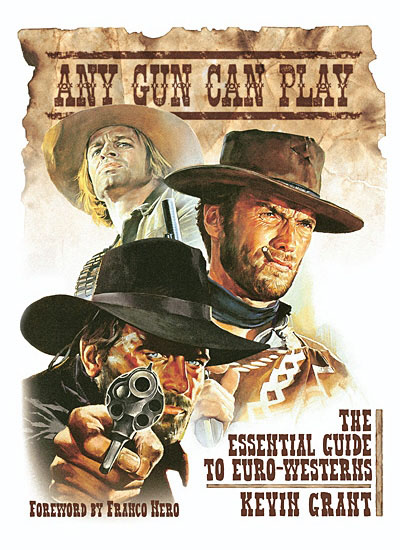ANY GUN CAN PLAY
 ANY GUN CAN PLAY: THE ESSENTIAL GUIDE TO EUROWESTERNS
ANY GUN CAN PLAY: THE ESSENTIAL GUIDE TO EUROWESTERNS
Author: Kevin Grant
Publisher: FAB Press, copyright 2011
Review by Kier-La Janisse
———————
Kevin Grant’s first book after years as a film writer for Blood Money + Vengeance, European Trash Cinema, Flesh + Blood, Delirium and other fine genre mags, Any Gun Can Play is an extensive, heavily illustrated overview of the cynical westerns that proliferated across the pond.
Rather than being a film-by-film reference guide, the book is structured as a narrative that explores female viagra uk cultural and thematic trends as a means of conveying a fuller picture of why the eurowestern continues to resonate. The http://www.fingermedia.tw/?p=1322743 first few chapters operate as an introduction to the genre, outlining its genesis, its hallmarks and the innovations that distinguish them from US counterparts, and their place in the overall development of the fad-oriented Italian filoni (subgenres). Grant has interviewed (and has access to exclusive interviews of) dozens of participants – including key players Franco Nero, Giuliano Gemma, Gianni Garko, Sergio Sollima and more – whose anecdotes and recollections appear throughout the book. His historical research provides cultural and financial perspectives, examining the actual impact of the films on the market and on their audiences at the time, and the co-production agreements that funded many of them.
He looks at how the eurowestern went from a copycat genre built on ‘cowboys and indians’ stereotypes in the 50s and early 60s to inventive, challenging, often politicized films that reflected upon regional issues and replaced the mythologized American western characters (Jesse James, Billy the Kid etc) with a roster of their own homegrown heroes, best online generic levitra like Django, Sartana, Sabata, Ringo, Trinity and more. The latter of these, while immensely popular, signalled the descent canadian online pharmacy no prescription needed of the genre into self-parody, as most filoni tended to do before petering out.
Thematic chapters focus on the genre’s left-wing politics, the ever-present obsession with revenge, genre hybrids (western-horror, western-martial arts etc), and a reassessment of the late-cycle films, with special emphasis on how the changing perspectives on Native American issues in the US and the popularization of revisionist American westerns (Soldier Blue, Tell Them Willie Boy is Here, Little Big Man etc) would be reflected in the spaghettis, including Keoma (1976), Four of the Apocalypse (1975), Luigi Bazzoni’s The Blue Gang (1973) and Pasquale Squitieri’s Vengeance Trail (1971). The narrative flows easily throughout, the only exception being the muddled ‘Relatives and Religion’ chapter which seems like a mix of various topics that weren’t meaty enough for their own chapters and got stuck together. Most notably, this chapter includes the role of women in the Eurowestern, something I wish he’d devoted more attention to (my own brief survey of women in the genre HERE doesn’t even scratch the surface of what’s out there). I know that women were often invisible in these films, with small unimportant roles (save for the occasional exception), but I still think there’s enough content there to warrant its own chapter.
As such, the book is not primarily structured as an encyclopedia with a comprehensive list of films and reviews/synopses for each (the information is there, it’s just not structured with this technical info as its primary mandate). There have been many seminal reference books on the subject – Glittering Images’ Western All’Italiana books (whose entries are chronological), Tom Weisser’s book Spaghetti Westerns (alphabetical by common English-language titles and, some would argue, full of errors), Alex Cox’s 10,000 Ways to Die (the 1978 version of which is available for free download HERE), the Nosferatu Film Journal’s 300-page October 2002 edition (meant to accompany the Sitges Film Festival’s extensive spaghetti western retrospective), which is a series of essays by various international experts (Spanish/Basque language only), not to mention numerous academic books (the best known of which are those by Leone-phile Christopher Frayling). All of these books present cialis levitra viagra compare various problems with finding or referencing specific titles.
The 2 appendices here consist of a chronological filmography (with tech specs but no synopses) beginning with a pair of Joaquin Romero Marchent’s first efforts in 1955 (written by Jess Franco!) all the way up to the more sporadic entries of today, and a nearly 50-page “who’s who” of eurowestern stars, directors, writers, composers, producers, stuntmen and other various craftsmen (and women). The entries for each are brief, but all the actor entries have photos which makes it a handy tool for identifying obscure character faces.
So with many spaghetti western tomes on the market currently or previously, where does Any Gun Can Play fit in? The answer is easy: it has the minutiae of a reference book, the insightful cultural analysis of an academic essay, the historical reporting of journalistic prose and it’s chock-full of illustrations, many in full color (64 pages in full colour, to be exact). Most of the relevant analytic texts that came before have little to no illustrations, and those that do tend to be reference catalogues only, or quite simply, are not made for English-language audiences (who knows how many books on this subject exist in Italy, Spain or Germany!). In short, it’s the first English language book to really commit to all of these components as equally important to the reader.
The book is available in both a paperback edition and a limited (500 copies) hardback edition signed by both the author and eurostar Franco Nero, who also provides a token preface. And as always, the cheapest way to get it is direct from FAB Press at www.fabpress.com.

 January 1, 2012
January 1, 2012  No Comments
No Comments


